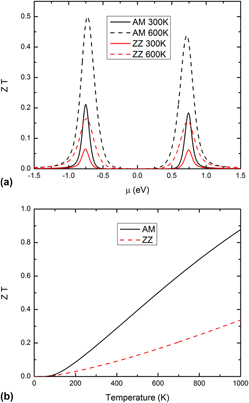Crossref Citations
This article has been cited by the following publications. This list is generated based on data provided by
Crossref.
Zhang, Gang
and
Zhang, Yong-Wei
2017.
Thermoelectric properties of two-dimensional transition metal dichalcogenides.
Journal of Materials Chemistry C,
Vol. 5,
Issue. 31,
p.
7684.
Lewis, Edward A.
Brent, Jack R.
Derby, Brian
Haigh, Sarah J.
and
Lewis, David J.
2017.
Solution processing of two-dimensional black phosphorus.
Chemical Communications,
Vol. 53,
Issue. 9,
p.
1445.
Liu, Bo
Bai, Lichun
Korznikova, Elena A.
Dmitriev, Sergey V.
Law, Adrian Wing-Keung
and
Zhou, Kun
2017.
Thermal Conductivity and Tensile Response of Phosphorene Nanosheets with Vacancy Defects.
The Journal of Physical Chemistry C,
Vol. 121,
Issue. 25,
p.
13876.
Zhang, Gang
and
Zhang, Yong-Wei
2017.
Thermal properties of two-dimensional materials.
Chinese Physics B,
Vol. 26,
Issue. 3,
p.
034401.
Bui, H.D.
and
Yarmohammadi, Mohsen
2018.
Direction-dependent electronic thermal conductivity and thermopower of single-layer black phosphorus in the presence of bias voltage and dilute charged impurity.
Physica E: Low-dimensional Systems and Nanostructures,
Vol. 103,
Issue. ,
p.
76.
Tanaka, Yuto
Saito, Mineo
and
Ishii, Fumiyuki
2018.
Anisotropic thermoelectric effect on phosphorene and bismuthene: first-principles calculations based on nonequilibrium Green’s function theory.
Japanese Journal of Applied Physics,
Vol. 57,
Issue. 12,
p.
125201.
Hong, Yang
Zhang, Jingchao
and
Cheng Zeng, Xiao
2018.
Thermal transport in phosphorene and phosphorene-based materials: A review on numerical studies.
Chinese Physics B,
Vol. 27,
Issue. 3,
p.
036501.
Cheng, Yuan
Zhang, Gang
Zhang, Yingyan
Chang, Tienchong
Pei, Qing-Xiang
Cai, Yongqing
and
Zhang, Yong-Wei
2018.
Large diffusion anisotropy and orientation sorting of phosphorene nanoflakes under a temperature gradient.
Nanoscale,
Vol. 10,
Issue. 4,
p.
1660.
Kaur, Kulwinder
Murali, Devaraj
and
Nanda, B. R. K.
2019.
Stretchable and dynamically stable promising two-dimensional thermoelectric materials: ScP and ScAs.
Journal of Materials Chemistry A,
Vol. 7,
Issue. 20,
p.
12604.
Le, P.T.T.
and
Yarmohammadi, M.
2019.
Tuning thermoelectric transport in phosphorene through a perpendicular magnetic field.
Chemical Physics,
Vol. 519,
Issue. ,
p.
1.
Korotcenkov, Ghenadii
2019.
Black Phosphorus-New Nanostructured Material for Humidity Sensors: Achievements and Limitations.
Sensors,
Vol. 19,
Issue. 5,
p.
1010.
Hu, R.
Zhou, Z. Z.
Sheng, C. Y.
Wang, L.
Liu, J. H.
Han, S. H.
and
Liu, H. J.
2020.
Surprisingly good thermoelectric performance of a black phosphorus/blue phosphorus van der Waals heterostructure.
Physical Chemistry Chemical Physics,
Vol. 22,
Issue. 39,
p.
22390.
Liu, Xiangjun
Gao, Junfeng
Zhang, Gang
Zhao, Jijun
and
Zhang, Yong-Wei
2020.
Remarkable Role of Grain Boundaries in the Thermal Transport Properties of Phosphorene.
ACS Omega,
Vol. 5,
Issue. 28,
p.
17416.
Chen, Yichuan
and
Sun, Mengtao
2021.
Two-dimensional WS2/MoS2 heterostructures: properties and applications.
Nanoscale,
Vol. 13,
Issue. 11,
p.
5594.
Rezania, H.
Abdi, M.
and
Astinchap, B.
2021.
Optical absorption of phosphorene structure in the presence of spin–orbit coupling: mechanical strain effects.
The European Physical Journal Plus,
Vol. 137,
Issue. 1,
Gaonkar, Narayan
and
Vaidya, R.G.
2022.
Electronic transport and Wiedemann-Franz law in 2D phosphorene.
Materials Today: Proceedings,
Vol. 64,
Issue. ,
p.
1685.
Gaonkar, Narayan
and
Vaidya, Ratnakar
2022.
Anisotropic Behavior of Thermoelectric Power in Zigzag and Armchair 2D Phosphorene.
physica status solidi (RRL) – Rapid Research Letters,
Vol. 16,
Issue. 7,
Kaur, Kulwinder
Khandy, Shakeel Ahmad
Dhiman, Shobhna
Sharopov, Utkir Bahodirovich
and
Singh, Jaspal
2022.
Computational prediction of thermoelectric properties of 2D materials.
Electronic Structure,
Vol. 4,
Issue. 2,
p.
023001.
Elahi, Ehsan
Al-Kahtani, Abdullah A.
Dastgeer, Ghulam
Aftab, Sikandar
Aziz, Jamal
Iqbal, Muhammad Waqas
Manzoor, Mumtaz
Jeong, Jian
Suleman, Muhammad
Ahmed, Bilal
Koyyada, Ganesh
and
Sharma, Pradeep Raj
2023.
Recent advances in thermomagnetic devices for spin-caloritronic phenomena.
Applied Materials Today,
Vol. 32,
Issue. ,
p.
101846.
Bazrafshan, M. Amir
and
Khoeini, Farhad
2023.
Electronic transport and thermoelectric properties of phosphorene nanodisk under an electric field.
Frontiers in Physics,
Vol. 10,
Issue. ,






